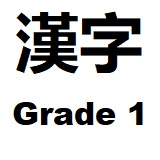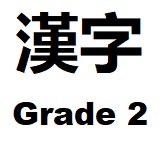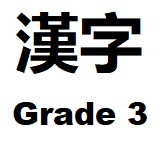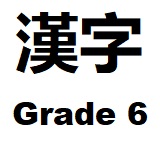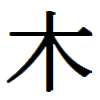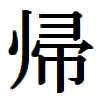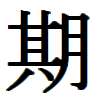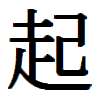 Kanji (漢字) are the Chinese characters used in the modern
Japanese writing system along with hiragana (平仮名), katakana (片仮名), romaji, and the Arabic numerals. The Japanese term kanji (漢字)
literally means "Han characters." Kanji (漢字) are the Chinese characters used in the modern
Japanese writing system along with hiragana (平仮名), katakana (片仮名), romaji, and the Arabic numerals. The Japanese term kanji (漢字)
literally means "Han characters." |
|
|
|
|
Because of the way they have been adopted into Japanese, a single
kanji may be used to write one or more different words, or sounds.
From the point of view of the reader, kanji are said to have one or
more different "readings." Deciding which reading is used will
depend on context, intended meaning, use in compounds, and even
location in the sentence. These readings are normally categorized as
either onyomi (Chinese reading) or kunyomi (Japanese reading). Some
common kanji have combinations of ten or more possible onyomi and
kunyomi readings. This is why Japanese is very difficult to read and
write.
The onyomi (音読み), Chinese reading, is a Japanese approximation of
the Chinese pronunciation of the character at the time it was
introduced. Some kanji were introduced from different parts of China
at different times, and so have multiple onyomi, and often multiple
meanings.
The kunyomi (訓読み), Japanese reading, or native reading, is a reading
based on the pronunciation of a native Japanese word that closely
approximated the meaning of the Chinese character when it was
introduced. As with onyomi, there can be multiple kunyomi readings
for the same kanji, and some kanji have no kunyomi at all.
When to use which reading
Although there are general rules for when to use onyomi and kunyomi,
the language is littered with exceptions, and it is not always
possible for even a native speaker to know how to read a character.In general, the following rules apply to
most situations.
|
- Kanji which are isolated, i.e. a character representing a single
word unit, are typically read using kunyomi:
- 月 tsuki "moon"
- 情け nasake "sympathy"
- 赤い akai "red"
- 新しい atarashii "new "
- 見る miru "(to) see"
- Kanji occurring in compounds are generally read using onyomi:
- 情報 jōhō "information"
- 学校 gakkō "school"
- 新幹線 shinkansen "bullet train"
|
|
Consider the following |
- The isolated kanji and compound kanji distinction gives
words for similar concepts completely different pronunciations:
- 東 "east" and 北 "north" use the kunyomi readings higashi
and kita, being stand-alone characters
- while 北東 "northeast", as a compound, uses the onyomi
reading hokutō
|
|
Additional notes |
- Meaning can also be an important indicator of reading; 易 is
read i when it means "simple", but as eki when it means
"divination", both being onyomi for this character.
- Kunyomi compound words are not as numerous as those with
onyomi, but they do occur. Examples include 手紙 tegami "letter",
日傘 higasa "parasol", and the famous 神風 kamikaze "divine wind".
Such compounds may also have okurigana, such as 空揚げ (also
written 唐揚げ) karaage "fried food" and 折り紙 origami, although many
of these can also be written with the okurigana omitted (e.g. 空揚
or 折紙). Note: Okurigana (送り仮名, literally "accompanying letters") are
kana suffixes following kanji stems in Japanese written words.
- Some onyomi characters can also be used as words in
isolation: 愛 ai "love", 禅 Zen, 点 ten "mark, dot". Most of these
cases involve kanji that have no kunyomi, so there can be no
confusion, although exceptions do occur. A lone 金 may be read as
kin "gold" or as kane "money, metal"; only context can determine
the writer's intended reading and meaning.
- Multiple readings have given rise to a number of homographs,
in some cases having different meanings depending on how they
are read. One example is 上手, which can be read in three
different ways: jōzu (skilled), uwate (upper part), or kamite
(upper part). In addition, 上手い has the reading umai (skilled).
Note: Furigana is often used to clarify any potential ambiguities.
Furigana (振り仮名, Furigana) is a Japanese reading aid, consisting
of smaller kana printed next to or above a kanji or other character to
indicate its pronunciation.
- As stated above, all four combinations of reading are possible:
on-on, kun-kun, kun-on and on-kun.
- Some famous place names, including those of Tokyo (東京 Tōkyō) and
Japan itself (日本 Nihon or sometimes Nippon) are read with onyomi;
however, the majority of Japanese place names are read with kunyomi:
大阪 Ōsaka, 青森 Aomori, 箱根 Hakone.
- When characters are used as abbreviations of place names, their
reading may not match that in the original. The Osaka (大阪) and Kobe
(神戸) baseball team, the Hanshin (阪神) Tigers, take their name from
the onyomi of the second kanji of Ōsaka and the
first of Kōbe. The name of the Keisei (京成) railway line, linking
Tokyo (東京) and Narita (成田) is formed similarly, although the reading
of 京 from 東京 is kei, despite kyō already being an onyomi in the
word Tōkyō.
- Family names are also usually read with kunyomi: 山田 Yamada,
田中 Tanaka, 鈴木 Suzuki. Given names often contain mixtures of kunyomi
and onyomi: 大助 Daisuke [on-kun], 夏美 Natsumi [kun-on]. Being
chosen at the discretion of the parents, the readings of given
names do not follow any set rules and it is impossible to know
with certainty how to read a person's name without independent
verification. Common patterns do
exist, however, allowing experienced readers to make
a good guess for most names.
|
|
The kanji introduced on these pages follow the same learning order as
taught in the Japanese schools. At this time the kyouiku kanji are
listed which are the 1006 kanji students in Japan are required to
learn through grade 6 of elementary school. An additional 949 kanji
will be added to these pages someday, which when combined with the kyouiku kanji, make up the
1945 kanji characters known as jouyou kanji, which students in Japan are
required to learn through grade 12 of high school. |
|
|
|
Representing Sounds
The following shows the only way the sound
ki can be written in romaji, hiragana, and
katakana, and one of the many ways ki can be written in kanji. |
|
Romaji |
Hiragana |
Katakana |
kanji |
ki |
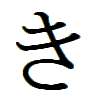 |
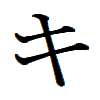 |
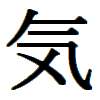 |
|
The sound ki can be written
with many different kanji. Keep in mind most kanji have two
or more pronunciations....The Chinese pronunciation known as
onyomi, and the Japanese pronunciation known as
kunyomi.
The onyomi (音読み), Chinese reading, is a Japanese approximation of
the Chinese pronunciation of the character at the time it was
introduced. Some kanji were introduced from different parts of China
at different times, and so have multiple onyomi, and often multiple
meanings.
The kunyomi (訓読み), Japanese reading, or native reading, is a reading
based on the pronunciation of a native Japanese word that closely
approximated the meaning of the Chinese character when it was
introduced. As with onyomi, there can be multiple kunyomi readings
for the same kanji, and some kanji have no kunyomi at all.
The following are examples of ten kanji that have the sound
ki. |
|
 Japanese
Hiragana Katakana Kanji
Japanese
Hiragana Katakana Kanji

